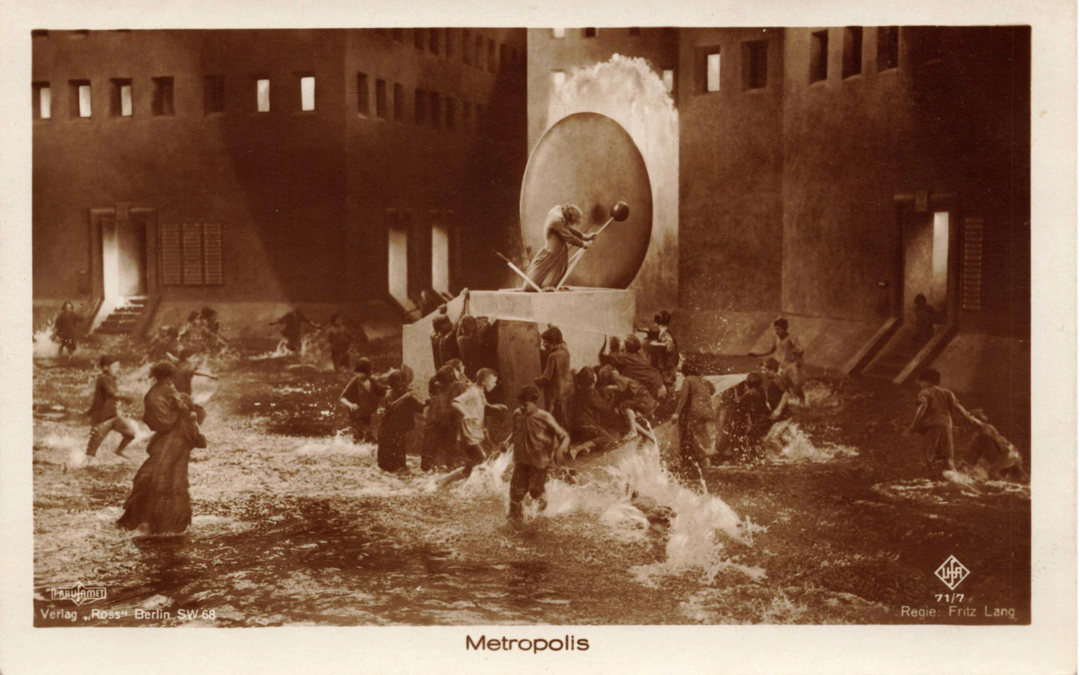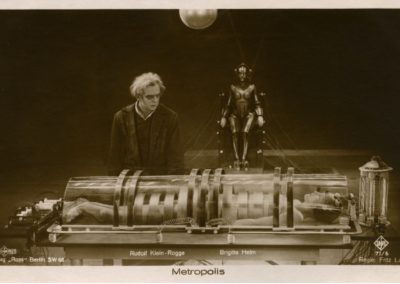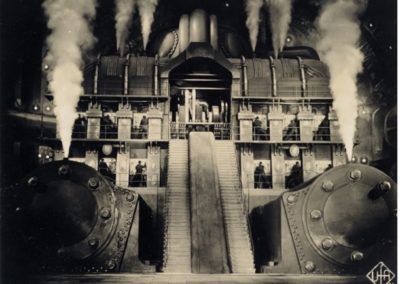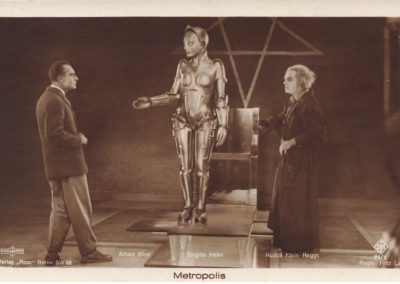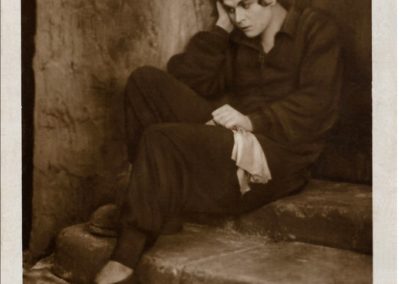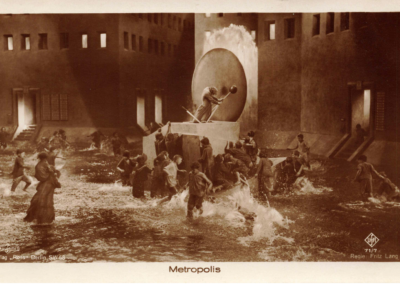 Based on Thea von Harbou’s 1925 science fiction novel, Metropolis, Fritz Lang’s 1927 film was one of the most visually stunning productions of the Weimar period (historical period of Germany from November 9, 1918 to March 23, 1933). Lang had previously made several ground-breaking films, including The Spiders (1919) and Dr. Mabuse the Gambler (1922). Metropolis began filming in 1926 and took over 17 months to complete. The initial production budget for Metropolis was $356,295, but grew to more than $1,187,648 (about $20.7M today). Compared with other major films of the era, creating Metropolis cost about the same as the The Ten Commandments in 1923, and a little less than half of the U.S production of Ben Hur in 1926. At 2.5 hours it was very long for a silent film, so several shortened, edited versions were quickly produced and distributed.
Based on Thea von Harbou’s 1925 science fiction novel, Metropolis, Fritz Lang’s 1927 film was one of the most visually stunning productions of the Weimar period (historical period of Germany from November 9, 1918 to March 23, 1933). Lang had previously made several ground-breaking films, including The Spiders (1919) and Dr. Mabuse the Gambler (1922). Metropolis began filming in 1926 and took over 17 months to complete. The initial production budget for Metropolis was $356,295, but grew to more than $1,187,648 (about $20.7M today). Compared with other major films of the era, creating Metropolis cost about the same as the The Ten Commandments in 1923, and a little less than half of the U.S production of Ben Hur in 1926. At 2.5 hours it was very long for a silent film, so several shortened, edited versions were quickly produced and distributed.
The futuristic, expressionist above-ground and dystopian below-ground scenes created for the film were innovative and shocking and significantly influenced visual science fiction depictions in movies from Flash Gordon to Blade Runner. The public learned of Fritz Lang’s futuristic imagery through production stills made during the filming, including printed material such as programs and posters and a series of real photographic postcards with a series of striking images extracted from the film. Few of the production stills were produced, and today they are very rare. The contemporary real** photographic postcards were produced in greater numbers, but most particularly, the iconic images of the robot are relatively uncommon today and are highly sought by collectors.
The series of Metropolis real photographic postcards were produced by Ross Verlag, a German postcard publishing company established by photographer Heinrich Ross in Berlin in 1919. These postcards began production between 1927 and 1928 and are numbered from 71/1 to at least 71/12. Several of the images are similar to the production stills, but appear to have been made from actual scenes in the film including two striking iconic scenes of one of the stars, Brigitte Helm as Maria and the Robot.
Ross published thousands of high quality silver bromide real photographic postcards with many popular celebrities including actors and dancers, and theatric tableaux. Ross Verlag often published series of images of popular European and English stars and American film actors. Many are glamour poses with others in costume from plays and motion pictures, synergistically taking advantage of the public interest and helping to promote the celebrities and the films. It is not clear how many copies were made or how long the Metropolis cards were produced.
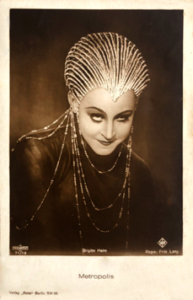 The success and stunning visual settings of Metropolis, and the popularity of its stars made the film a natural subject for Ross. Eighteen-year-old Brigitte Helm burst into stardom from her dual roles as Maria, and the Robot. Helm appears in many of the postcards and continued to be a popular subject for Ross as she continued her rise to stardom with roles in later films.
The success and stunning visual settings of Metropolis, and the popularity of its stars made the film a natural subject for Ross. Eighteen-year-old Brigitte Helm burst into stardom from her dual roles as Maria, and the Robot. Helm appears in many of the postcards and continued to be a popular subject for Ross as she continued her rise to stardom with roles in later films.
Other stars from Metropolis who also became, and remained popular subjects for Ross real photographic postcards into the 1930s included Gustav Fröhlich (in the role of Freder Fredersen), Alfred Abel (in the role of Johann Fredersen, and Rudolf Klein-Rogge (in the role of Erfinder C. A. Rotwang).
Heinrich Ross was Jewish and when the Nazis came to power in 1933, they took control of his company. Ross Verlag continued tp produce postcards, but the quality soon suffered, and image content shifted from actors and celebrities to propaganda. Ross eventually left Germany in 1939, arriving in the United States in 1942 as a refugee after a strenuous trip via Cuba, Belgium, Netherlands, France, and England. He eventually settled with his son in Chicago, working in a machine shop until he died at the age of 86 on August 3, 1957.
Seeing the Ross postcards from Metropolis triggered memories of first seeing the film in high school. It was a catalyst in seeking and collecting Ross Verlag real photographic postcards. Thank you for letting me share a few thoughts and postcard images of Metropolis with you.
** Real photographic postcards were actually produced as printed photographs, usually as silver prints, though there are also cyanotype examples. The term differentiates these from the printed cards that were produced using printing processes that range from the high quality Albertype in the first decades of the 20th century to cheap halftones. The high silver content of the photographic postcard paper drew many fine art photographers to contact print their images on the 3 ½” x 5 ½” postcard paper. Examples include André Kertész, who did an entire exhibition printed on carte postale paper, as did Man Ray, Jessie Tarbox Beals, Lotte Jacobi, Walker Evans, and many of their contemporaries. One of Kertész postcards sold for $197,000 at Sotheby’s in 2014.

Jeremy Rowe
Contributing Writer
Jeremy Rowe has collected researched and written about historic photography for over 30 years. His collecting has focused on 19th and early 20th century photographs – ranging from daguerreotypes and cased images to mounted photographs, real photo postcards, and vernacular images with an emphasis on Arizona and the Southwest, Lower Manhattan, and the open-ended category of “images that strike me.”
Jeremy has curated exhibitions and served on the boards of the Daguerreian Society, National Stereoscopic Association, Daniel Nagrin Film, Theater and Dance Foundation, In Focus, and Ephemera Society of America. Jeremy is currently working with the Library of Congress Prints and Photographs to establish a National Stereoscopic Research Collection and Research Fellowship.
Jeremy has written numerous publications about historic photography, including Arizona Photographers 1865 – 1920 a History and Directory, Arizona Real Photo Postcards a History and Portfolio, and Arizona Stereographs 1865- 1930.
Jeremy has three degrees from Arizona State University and is an Emeritus Professor. He is currently a Senior Research Scientist at New York University and travels between New York City and Arizona.

